Recently, I’ve shared quite a few briefings by Jim Schatz. It’s not only because he recently passed away, but also because they are so timely. We are currently in a period of potential growth for the US military and Jim was always on top of missteps in the opportunities we’ve had to modernize our small arms. His last briefing to NDIA’s Armament Systems Forum, on 27 April, 2016 was entitled, “A Path To Overmatch” and made the case for an immediate transition to an intermediate caliber, preferably with a telescoping cased cartridge, along with a new weapon individual weapon. The reason was simple; overmatch. Our troops are outranged by threat weapons using the 7.62x54R cartridge. While not every enemy is equipped with a weapon in this caliber, they’ve learned to use their PKM MMGs and SVD Sniper Rifles to keep our troops at arm’s length. In the briefing, Jim does a great job of laying out Russian and ISIS capabilities vis-a-vis our US M4A1 and M249.
Jim named five things that could immediately be leveraged to provide overmatch: Lightweight Intermediate Caliber Cartridge (LICC) Ammo, Disturbed Reticle Carbine Sight, Blind-to-Barrier Bullets, Lightweight Modular Weapons and Advanced Training.
He also wanted the most bang for the buck and identified 140,000 “Frontliners” in the US military, aka trigger pullers, who would be the immediate focus of small arms modernization efforts.
Jim urged a transition to two calibers, a 6.5-family intermediate cartridge for the individual weapon and a .338 cartridge for crew served weapons. I recently discussed the General Dynamics Lightweight Medium Machine Gun in .338 Norma Magnum. Jim used this example to make the initial case for the transition to LICC ammo for the individual weapon.
Right now, all of the cartridges being seriously looked at are in the 6.5mm family; .260, .264 USA, and .277 USA. While .260 is currently commercially available, .264 USA and .277 USA were developed by the US Army Marskmanship Unit, who has been conducting in-house evaluations. Unfortunately, the US Army has not planned a formal caliber study until the early 2020s. But interestingly, use of a 6.5mm cartridge isn’t new. 6.5×55 Swedish saw service in Europe for a very long time. Initially developed in the 1890s, it was still in service up to a century later.
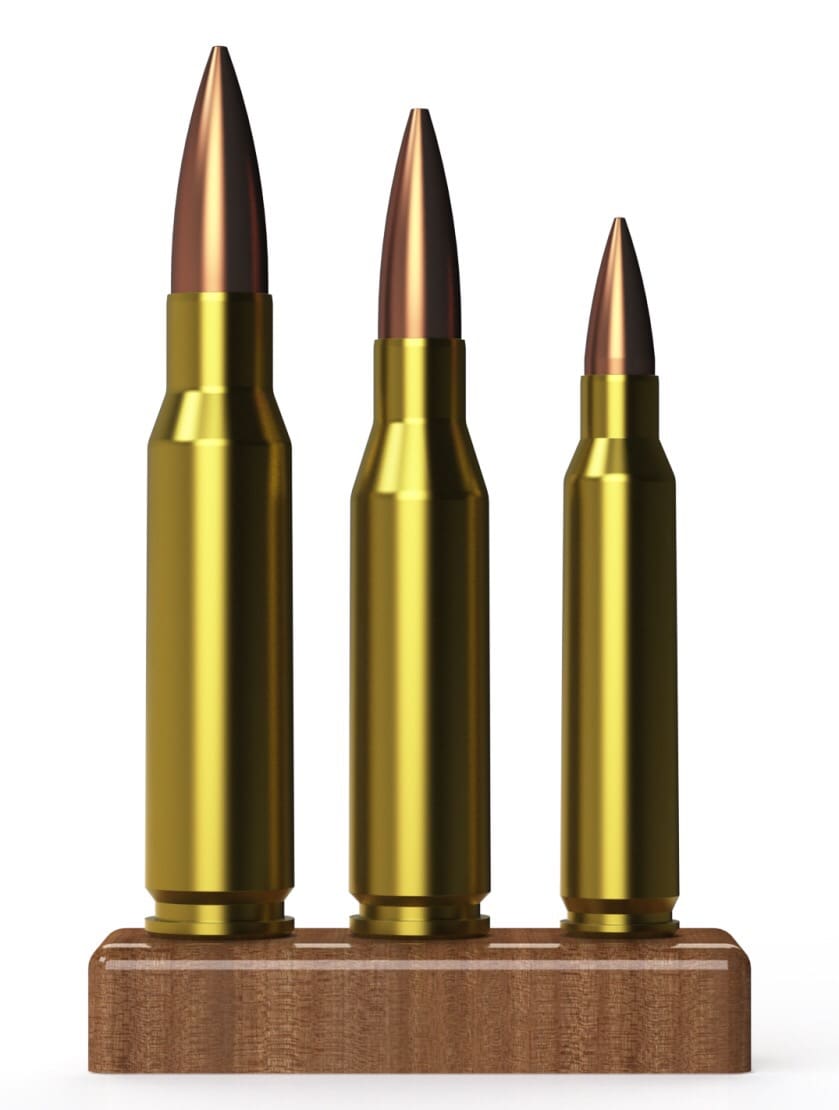
This image came from The Firearm Blog’s article on the .264 USA cartridge by Nathaniel F. It depicts (L-R) 7.62 NATO, .264 USA, 5.56 NATO.
Jim was very passionate about this concept and did the homework. For example, he knew the costs to not only pay for the transition to a new caliber, but new weapons as well. The figures are there, for you to see.
Jim’s attention to detail was always keen. He even considered spare parts, manuals, training and ranges in his calculations.
Naturally, transition to a larger caliber, means heavier ammo and a smaller basic load. Here, Jim shows the tradeoffs for the amount of amm a rifleman would carry in his basic load, based in different calibers.
There is a difference, and this is why the transition to Polymer cased/telescoping ammo is so important.
To summarize, these are the takeaways. All of this, is available from industry, right now.
While I cherry picked several slides from this briefing to make certain points, you really need to read the whole thing. I’ve only scratched the surface here. It’s filled with gems like the examples I’ve given.
You can download it here www.dtic.mil/ndia/2016/armament/18260_Schatz.


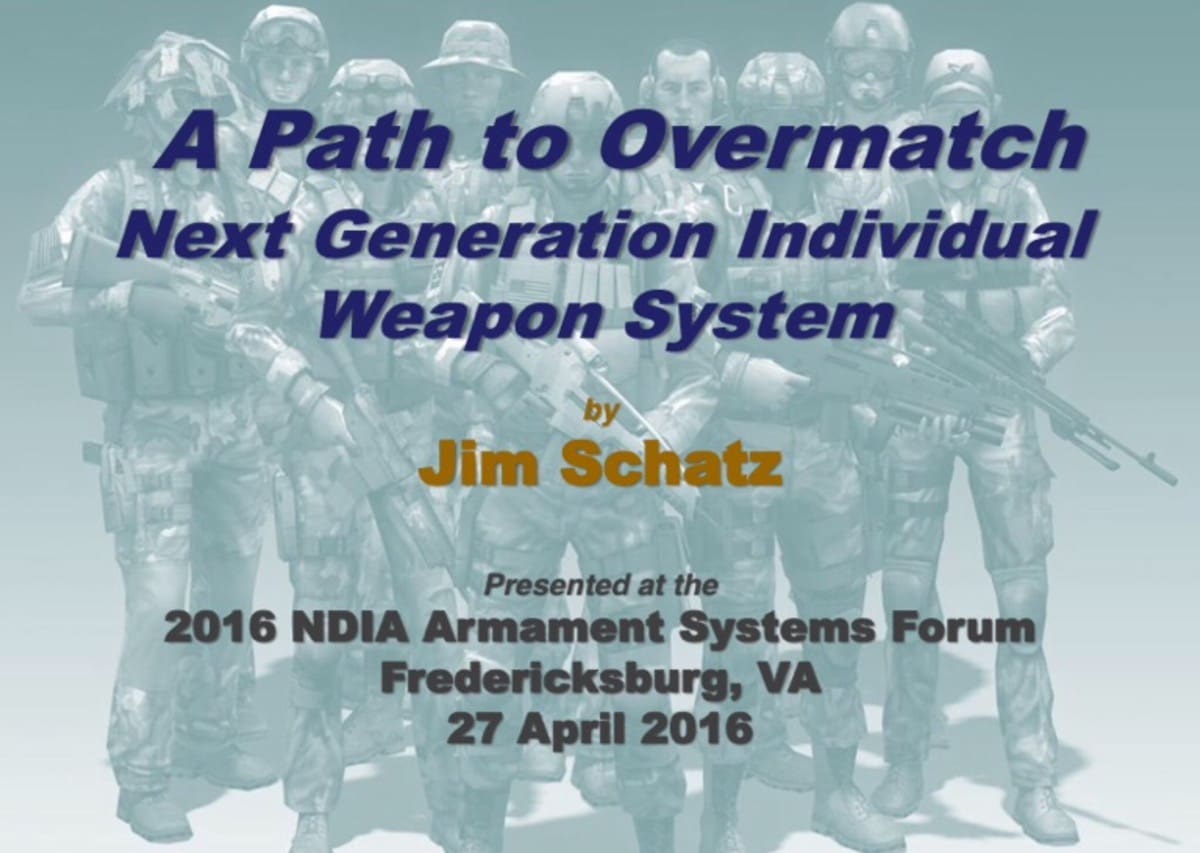
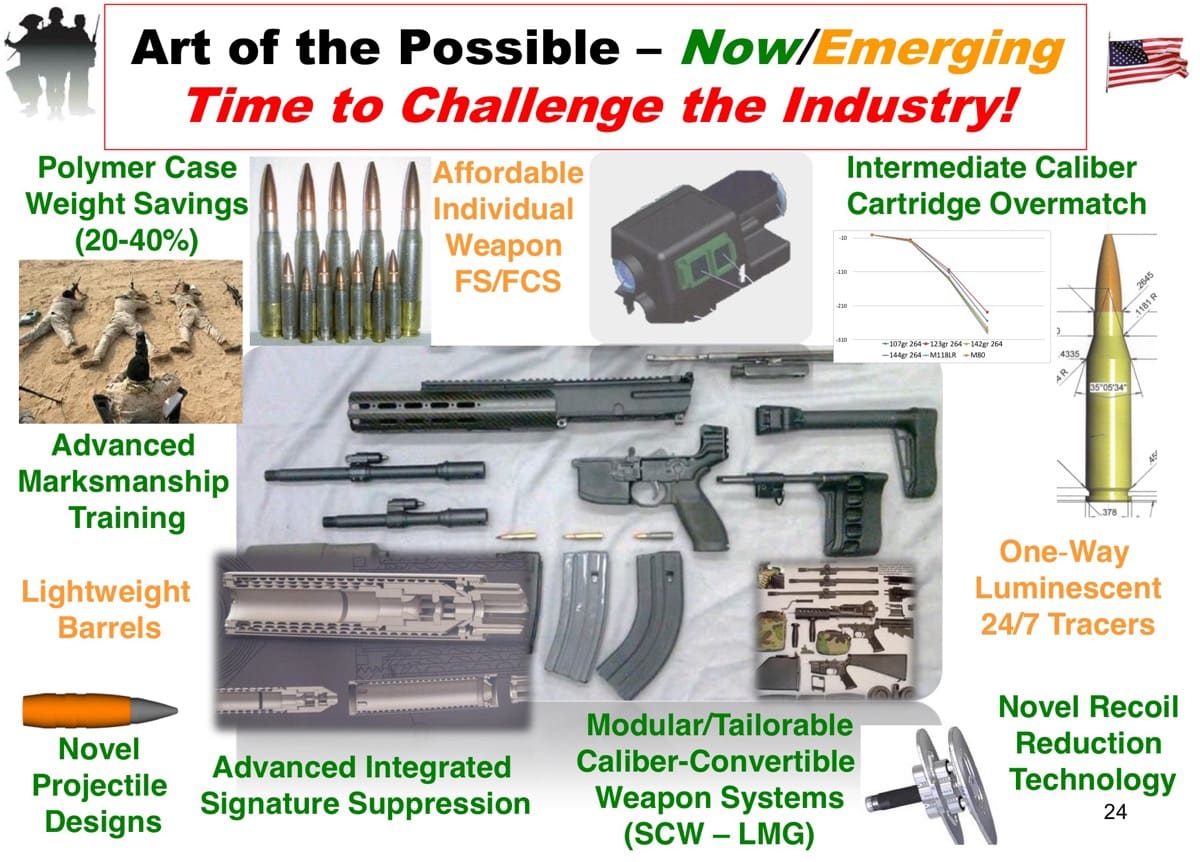
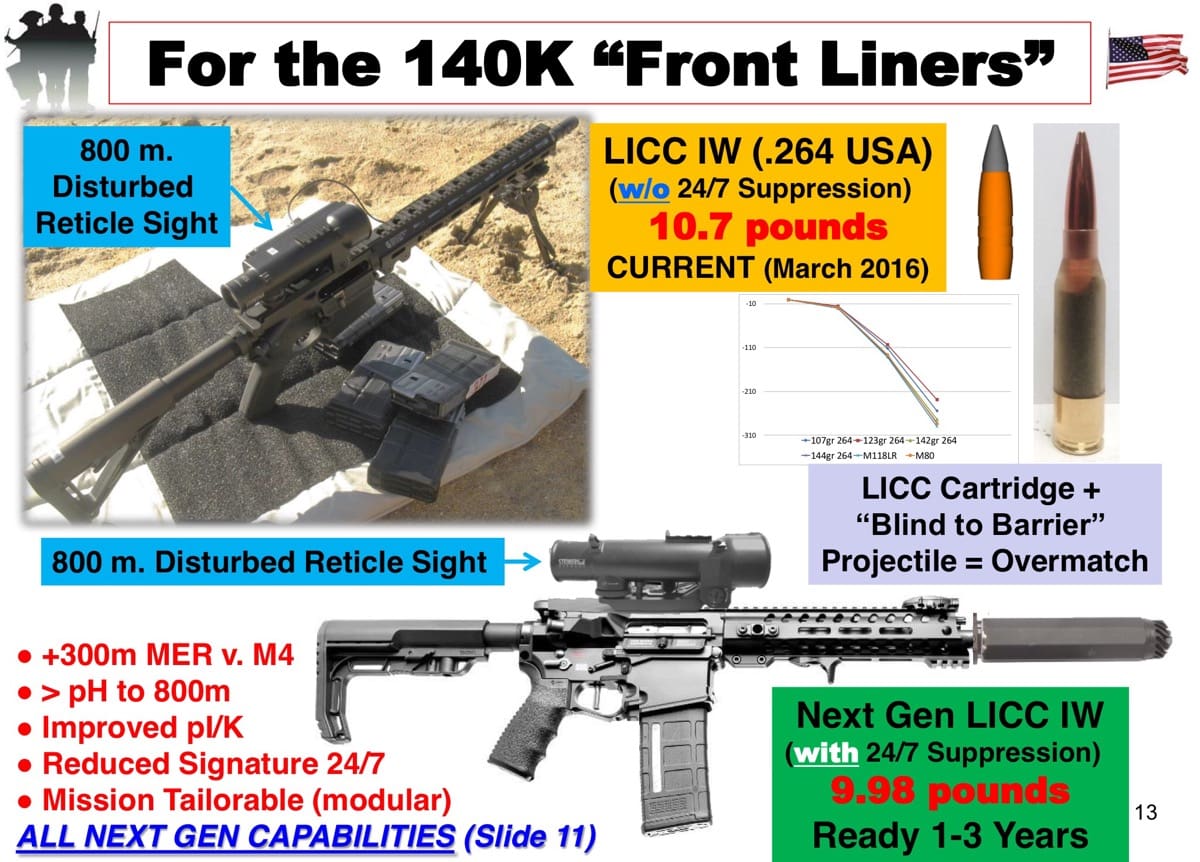
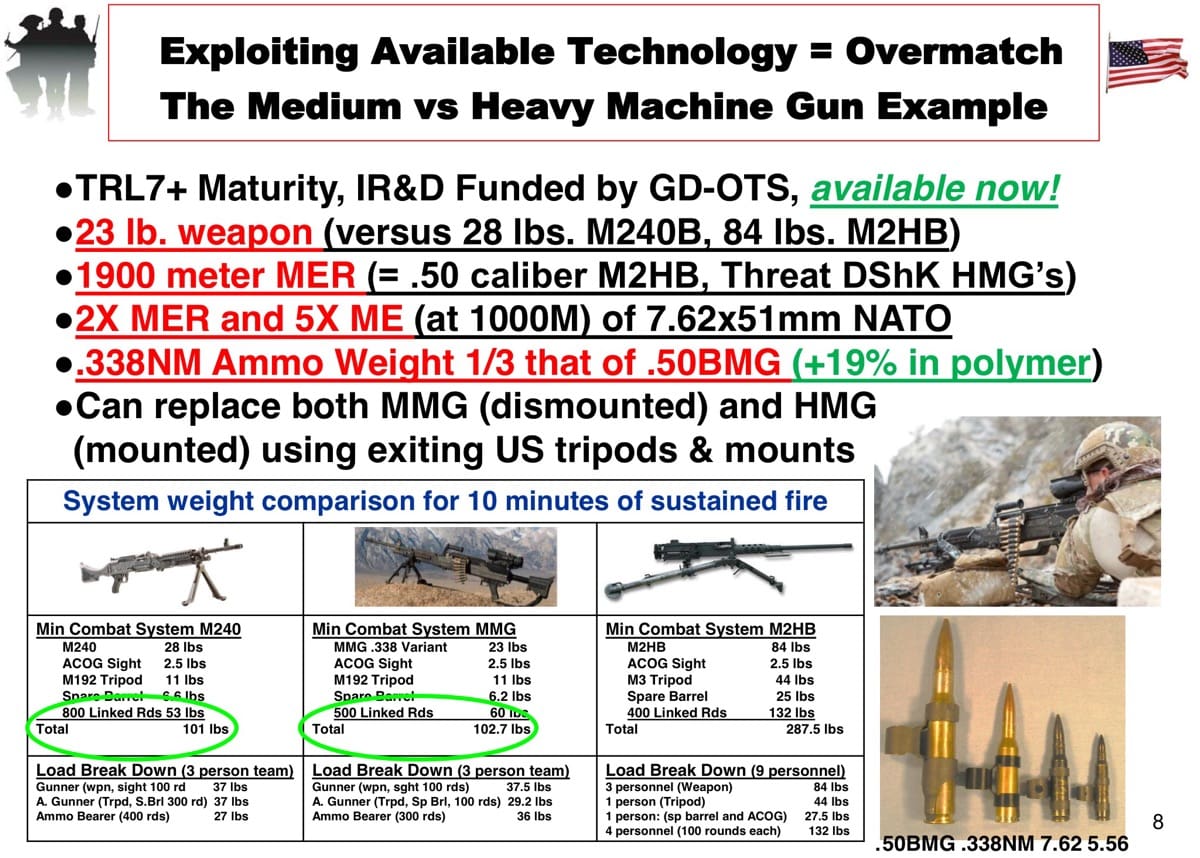

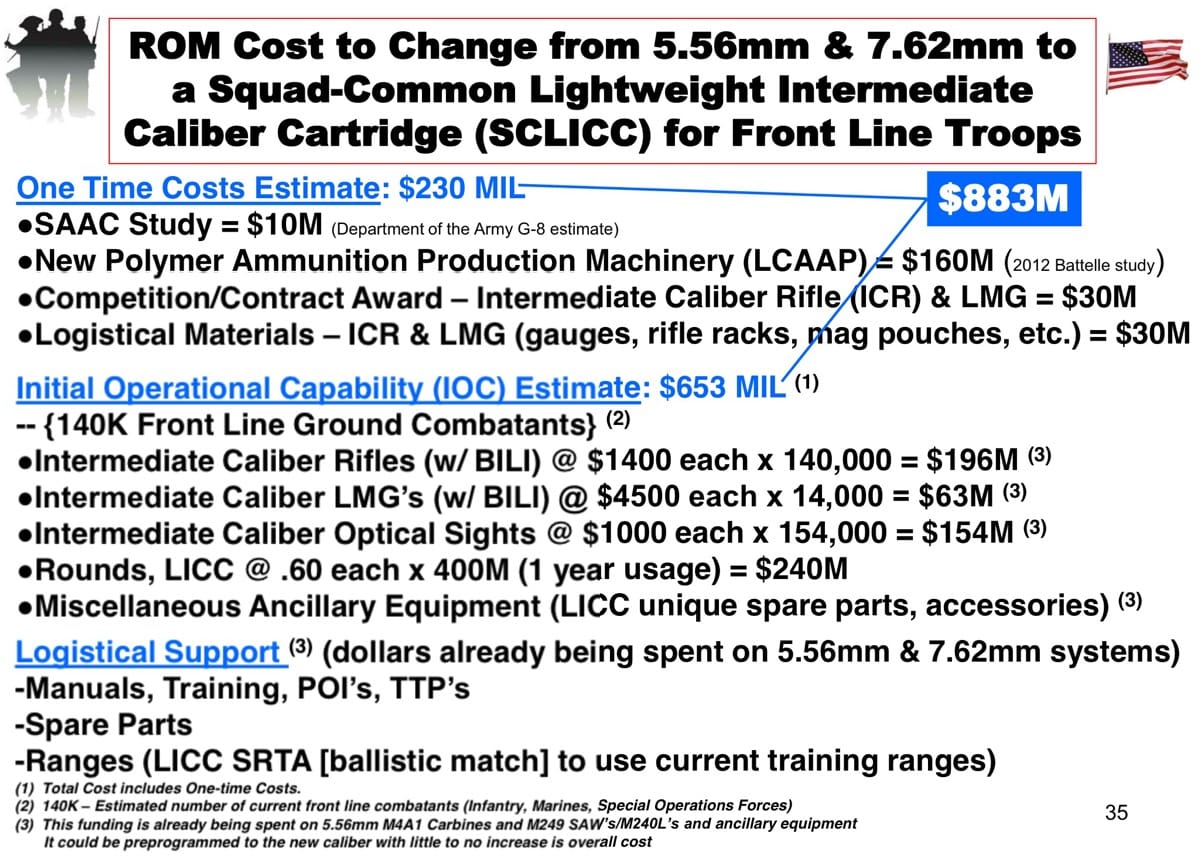
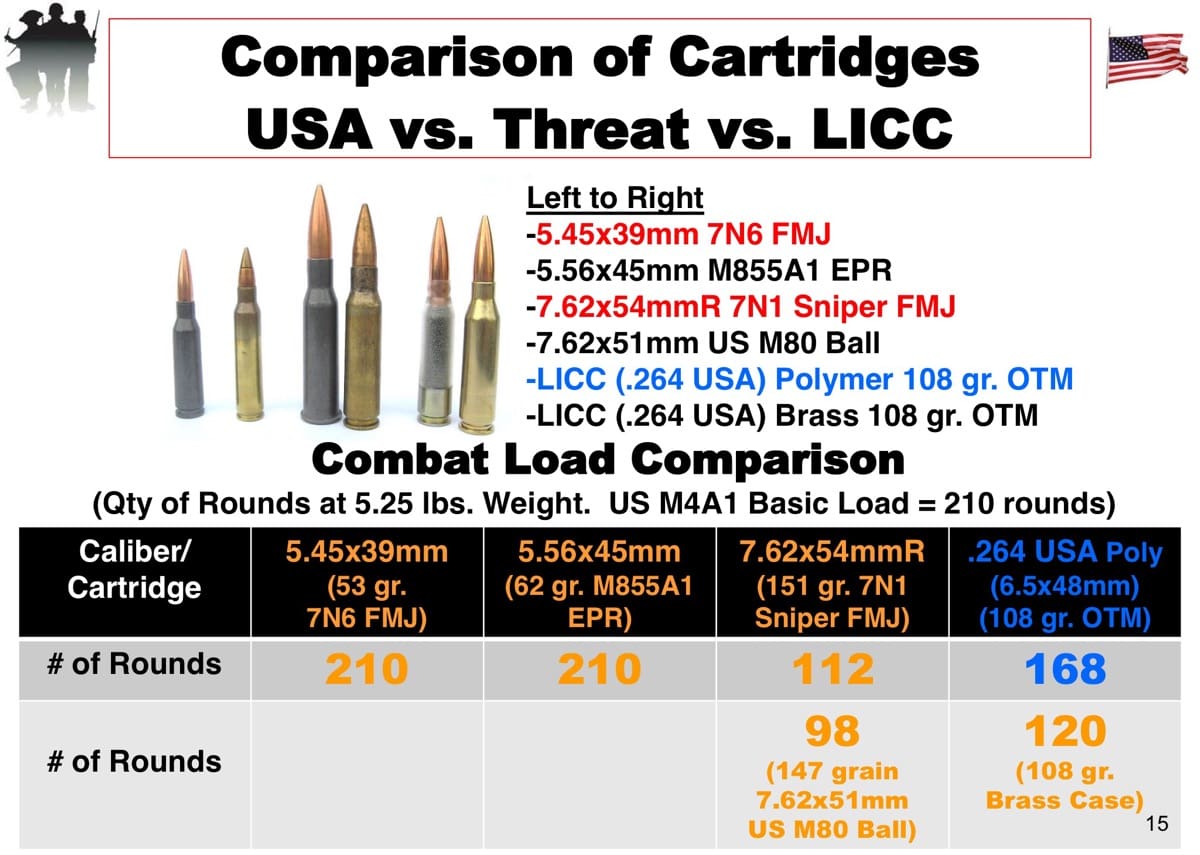
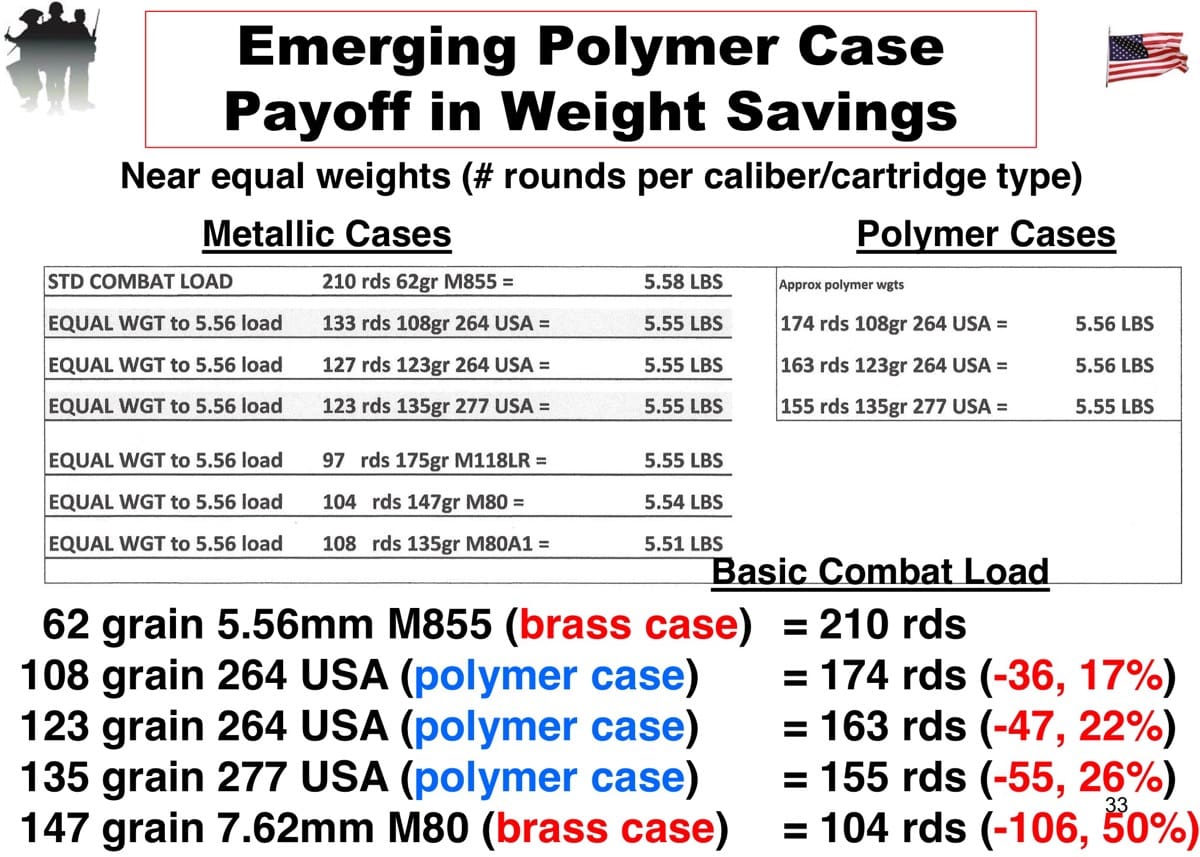
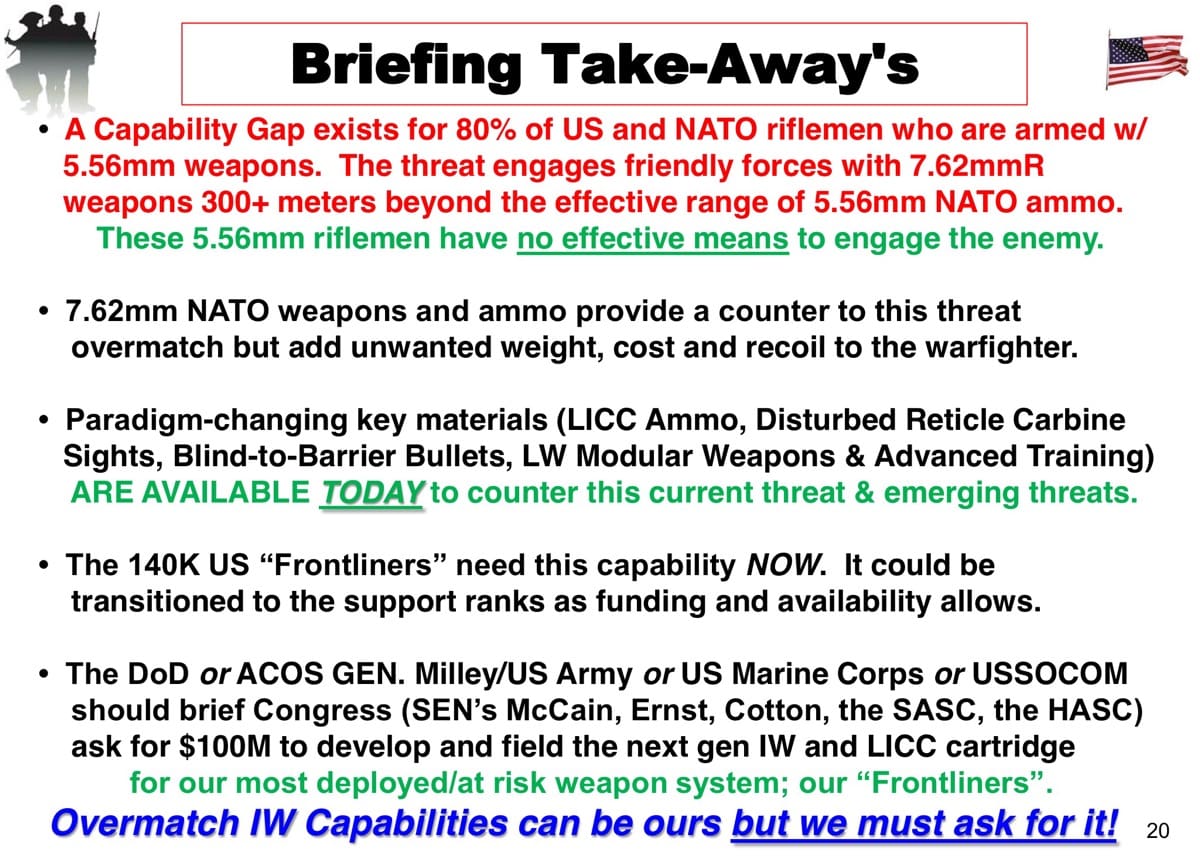
Thanks for sharing these great presentations by Jim.
I’m struck by the irony that on the one hand, as you say, the USA is presented with “opportunities we’ve had to modernize our small arms” but in this particular case it is in response to an enemy shooting bullets from rounds chambered in 7.62 x 54R, a cartridge developed by the Russian Empire, as far as I can tell, way back in 1891, over 125 years ago, fired from firearms that are essentially not much different than what they were back in the 1950s!
Around and around and around we go….
The “promises and virtues” of 6.XX intermediate cartridge and poly casings, again.
Let’s yet again, push an intermediate cartridge, for the intermediate cartridge, for that intermediate cartridge.
Before we start clamoring, again for a 6.XX intermediate cartridge, can poly cases actually work, and can it do everything better than M855A1 or heavier gran 5.56mm? Also, if poly cases work, it will of course be applied to 5.56mm.
There’s also a lot more to overmatch than engagement distances via small arms, which distance is main argument in the slide-show. Like engaging other forces in other places, other than just Hajj in the desert or barren mountains, forces that easily adapt to distance overmatch advantages Schatz’s is arguing for.
No disrespect to Mr. Schatz – I’m sure he knew the subject matter much better than most….
It just strikes me that we’ve been going back and forth over this ground since the 1950’s. Remember the .280 caliber round and the British EM2 and early FAL rifles?
Or what about the 6.8 SPC vs. 6.5 Grendel vs. 6.5 Creedmoor debates of recent times?
When will it ever be resolved?
I think the Grendel is the best you can do in the AR-15 size, while the Creedmoor and competitors are awesome in the short action. The AMU and everyone that has played with the .264 USA has been very impressed, so I’m excited to see what that brings.
There has also been a shift to .260 Remington in some circles, and that is a fantastic round for the AR-10 platform/whatever.
Schatz was always, and i mean always talking about how poly case is here and it works, yet I’ve never seen a SCHV poly case capable of being extracted.
Yet Jim guaranteed me they are out there and working better than brass.
I think it is safe to say that poly cased rounds are out there in a variety of T&E, maybe even fielding.
Not to add to mysticism, of course, but let’s be realistic and look at the efforts of Schatz and others.
I agree. I didn’t read the all presentation so I’ll not comment it right now, but the 5.56×45 can be effective at 600m if you tune it a bit. Regarding the current trend that want, for good reasons, to shorter the overall lenght of the rifles without using a bullpup configuration ; the future ammo should be tuned for a 12-14″max barrel.
For the lack of effectiveness at extended ranges, there are others solutions to counter this problem and far more effective than marksmen, one of them is armed drones.
M855A1 was designed for the 14.5″ M4.
The standard M4 or M16 doesn’t even have a free float handgaurd. so I don’t think that we are “tuning” anything. Addionally if the M855A1 and M80A1 bullet technology was placed in a 6.XX package it would be one seriously nasty round able to travel fast and heavy and seriously punch through barriers.
Of course this A1 style bullet could also be placed in a LSAT style case-telescoped round and that would be even lighter weight with same ballistic performance.
Or use existing Mk 262 72gr 5.56 OTM? Increase production scale?
Eric, thanks for picking the good stuff out and showing us this. I wonder what the likelihood of us actually getting any of this? Also would love to see the current offerings of disturbed reticle optics
The LSAT program is the way to go.
Also, those who urge for a heavier round for increased range seem to forget that most engagements occur within 300m. The basic rifle squad should be optimized for that. Now, if you add unnecessary range, then you create extra weight and/or reduce the potential firepower of the squad (less rounds).
Lets not forget that Afghanistan is only one conflict, and should not be considered the norm to based our ammunition on.
Historical data and future trends (urban combat/mega cities) all point to the 300m metric as the optimization point for the riflesquad.
300m, an enduring truth many forget.
Ah yes, the magical 300 meter distance “truth” raises its head…
Wasn’t this based on data gathered by the Germans in WWI and early WWII, and later verified by a review of that data by the American forces? This is what led to the development of the “intermediate” range cartridges like the German 7.92mm Kurz and the Soviet 7.62x39mm, and also led into the development and adoption of the 5.56x45mm and 5.45x39mm rounds by the US and USSR – first for the jungles of Vietnam and later for the mountains of Afghanistan…
How ironic. I wonder what the average range of engagements in Aleppo is? 😉
Under 100m, occasionally 200m???
I certainly don’t have the answers and I think anyone that claims to know the perfect solution for an ideal weapon/round/system that’s just dandy in every circumstance is probably spinning a tale.
Given the depth of knowledge and experience the writer clearly had I just feel very privileged to get to read all these presentations. Whether the idea proposed is ideal or not I think anyone ought to at least respect the view point.
Is there a place that has all of Jim’s presentations compiled?
No, you have to search through the NDIA proceedings archive at DTIC.
Thanks
there was some chatter that HKPRO might create a sticky thread with Jim’s contributions preserved. I don’t know if it will happen?
Fascinating presentation. Thanks SSD.
I’d love to get into the source data. Anecdotal stories imply extended range engagements but where’s the data?
I also don’t buy equipping every soldier with a weapon to match a sniper’s rifle or an enemy crew served weapon. We have a mix of weapons in the squad for a reason and also have crew served weapons though the case for GD’s LWMMG is getting better and better.
Having a 7.62 DMR per squad with a Distributed Reticle / Smart sight and a higher BC version of M85A1 seems like a much easier way to bridge the gap in the short term, until a full caliber review of the LSAT program can be completed.
I guess everyone is forgetting about the 2 different environments we have been fighting in for the past 15 yrs., such as desert and urban areas. Our M-4s and M-4A1s with 14.5″ barrels are suitable for urban areas, but not so much in wide open spaces with where longer range weapons are more suitable in desert areas. A better solution that should have been made was to transition to a 16″ barrel for our infantry weapons. This would be a better compromise for longer range and slightly higher velocity, approximately 900 mps, using our M-855 and M-855A1 5.56 caliber round verses the M-4s and M-4A1s with 14.5″ barrels.
We have not been focused on an European mid-temperate climate combat areas in a long time until Crimea happened. The 16″ barrel would still be beneficial in these urban areas and mid-temperate climates.
Most modern infantry combat rifles have 16″ barrels as a standard for a reason. If we need the extra range for engagements put 1 or 2 rifleman with that capability into an infantry squad. Start using LSAT technologies now and move back to the 12 man rifle squad for added capabilities.
always thought a 12 man squad to include a 3 man gun team per army light infantry squad was the way to go. let weapons squad have gustovs (ability to grab javelins) also outside the box and many will disagree but from my experiences i would also like to see weapons squad have 1-2 60mm mortars. in afghanistan we had 2 60mms issued per platoon and had a few guys tought how to hip fire. they were greatly effective and was a huge asset
I’m going to say that I agree with Mr. Schatz, up front. But… I would hesitate to actually impose these things on the forces without doing more to ensure that this is actually the right thing to do.
My credo has always been that the way to do this stuff is to first determine how we intend to use these weapons tactically and operationally, and then work backwards to design the cartridges and weapons. If your tactics and operational intent don’t include training your troops to identify targets at 800m, and then effectively fire their individual weapons at those targets, then the whole idea of issuing a cartridge/weapon combination that can do that is essentially pointless. Likewise, if you’re going to train for an 800m engagement, and then issue a cartridge/weapon combination that is only really reliably lethal out to 500m…? I think the reader can work out the problems with all that, in terms of wasted logistics and training time.
Figure out how you intend to employ these things, and then start thinking about what you want to develop and procure. Any other path is madness.
If chemically-propelled projectile weapons were a new technology, I’d say that perhaps the best way to proceed would be to develop the weapon first, and then throw it up against the tactical wall to see what happened. However, the point we are at right now is that these are well-understood technologies, and we should be working from the standpoint of “procure what supports our intent on how to fight”, instead of treating this all as some new thing that we just can’t predict that much about, yet…
I’m tired of all of the acronyms, buzz words, and war figthing challenge hyperbole. If you want regular soldies to achieve over match, give us the time, POI, and STRAC to train. A new “front liner” rifle will not replace or change how we have fought wars in the industrial era and continue to fight wars in the post industrial era. It would be nice to have a rifle effective out to 800m but I still have to identify engage and assess the target. Besides, soldiers are still going to carry as much “light weight” ammo and other “light weight” stuff as possible. RDECOM and PEO Soldier have been admiring this problem for far too long. The answer has been and always will be training.